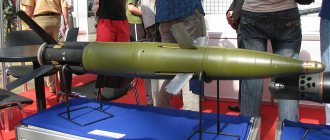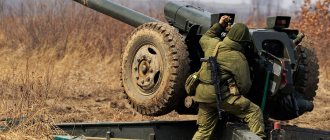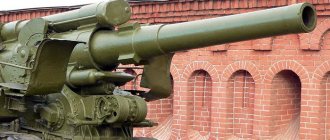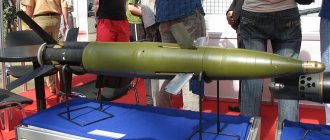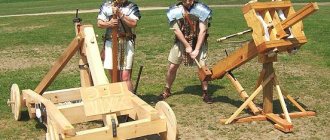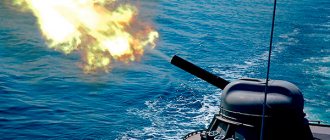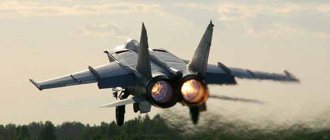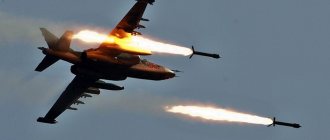The 152 mm Msta-B howitzer (2A65) can be considered the latest model in a long list of field howitzers of Soviet and now Russian design. However, relatively little is known about the 2A65 howitzer, also known under the designation “Msta-B” (in the West it is designated M1987), although recently it has been actively moving into the world arms market for possible export deliveries.
Characteristics of the 152-mm howitzer gun D-20
A country:USSRType:Howitzer gunDate of issue:1950Calculation:8 peopleCaliber:152.4 mmLength:8.63 m (barrel length 5.2 m, i.e. 34.2 caliber)Width:2.4 mWeight:5.65 tons (in combat position)Rate of fire:up to 6 rounds per minuteFiring distance:24 km (active-missile projectile), 17.4 km (high-explosive fragmentation projectile)Initial projectile speed:655 m/sAmmunition:No information
Characteristics and properties of ammunition
Main 152.4-mm howitzer shells: 1 - high-explosive steel fragmentation grenade 53-OF-530, 2 - steel cast iron fragmentation grenade 53-O-530, 3 - concrete-piercing projectile 53-G-530
The gun could fire the entire range of 152-mm howitzer shells, except for the naval semi-armor-piercing one. The cartridge case and charges from a 152-mm howitzer model were used. 1909/30, except full (only 4 charges). When firing the 4th charge, the fuses of the old shells (old Russian grenades 53-F-533 and others) were not cocked, so it was forbidden to fire these shells with the 4th charge. When the fuse of a high-explosive fragmentation howitzer grenade 53-OF-530 is installed for fragmentation action, its fragments scatter over an area of 2100 m²: 70 m along the front and up to 30 m in depth. If the fuse is set to high explosive, then when a grenade explodes in medium-density soil, a crater with a diameter of 3.5 m and a depth of about 1.2 m is formed.
| Ammunition nomenclature | |||||
| Type | GAU index | Projectile weight, kg | Explosive weight, kg | Initial speed, m/s | Table range, m |
| Concrete-piercing shells | |||||
| Concrete-piercing long-range howitzer (with the index Ш - equipped with TNT using the auger method) | 53-G-530 (53-G-530Sh) | 40,0 | 5,1 | ? | ? |
| High-explosive fragmentation shells | |||||
| Steel Long Range Grenade | 53-OF-530 | 40,0 | 5,47—6,86 | 344 | 8850 |
| Steel cast iron long range fragmentation grenade | 53-О-530А | 40,0 | 5,66 | ? | ? |
| Old grenade | 53-F-533 | 40,41 | 8,0 | 322 | 7290 |
| Old grenade | 53-F-533K | 40,68 | 7,3 | 322 | 7290 |
| Old grenade | 53-F-533N | 41,0 | 7,3 | 322 | 7290 |
| Old grenade | 53-F-533U | 40,8 | 8,8 | 322 | 7290 |
| Steel cast iron old French garnet | 53-F-534F | 41,1 | 3,9 | 322 | 7290 |
| Grenade from a 152 mm mortar mod. 1931 | 53-F-521 | 41,7 | 7,7 | ? | ? |
| Steel English grenade for 152 mm Vickers howitzer | 53-F-531 | 44,91 | 5,7 | ? | ? |
| Shrapnel | |||||
| Shrapnel with tube 45 sec. | 53-Sh-501 | 41,16—41,83 | 0.5 (680-690 bullets) | ? | ? |
| Shrapnel with T-6 tube | 53-Sh-501T | 41,16 | 0.5 (680-690 bullets) | ? | ? |
| Lighting shells | |||||
| Illuminating parachute, burning time 40 seconds. | 3S1 | 40,2 | ? | ? | ? |
| Chemical shells | |||||
| Chemical howitzer | 53-OX-530 | 38,8 | ? | 340 | 8796 |
| Chemical howitzer | 53-ХН-530 | 39,1 | ? | 344 | 8833 |
The history of the creation of the 152-mm howitzer gun D-20
The Soviet 152 mm D-20 gun-howitzer was created together with the 122 mm D-74 gun as a “hull duplex”. “Duplex” of two specialized, and at the same time assembled for the most part from the same blocks of artillery systems, made it possible, firstly, to solve the full range of tasks facing corps artillery, and secondly, it allowed to reduce costs and simplify repairs and operation, improve the supply of spare parts and training of artillery crews.
Both the 122-mm D-74 gun and the 152-mm D-20 gun-howitzer were designed immediately after the end of World War II at OKB-9 under the leadership of F. F. Petrov. The first prototype of the 122-mm D-74 cannon was manufactured by Plant No. 9 at the beginning of 1950, and on February 23, 1950 it was first tested by firing at the factory range.
With the D-20 it turned out more difficult - a monoblock 152-mm howitzer, originally called D-72, was ready in the same 1950. Only a slightly modified D-74 carriage was used as a carriage for it. But 2 years later (1952), the D-72 howitzer was reclassified into the D-20 howitzer gun (D is the factory index, and the number 20 is similar to the 152-mm ML-20 howitzer gun model 1937).
By 1953, 2 “hull duplex” batteries were manufactured, which began testing, which lasted until 1955. After completion of the tests, mass production of both guns was launched at , however, due to production delays, in fact, the first mass-produced D-74 and D-20 began to be mass-produced only in 1956.
Diagram of the 152-mm howitzer gun D-20
The D-20 became one of the first Soviet artillery systems capable of firing tactical nuclear and chemical ammunition, as well as the first 152 mm gun system with a semi-automatic wedge breech with vertical movement of the wedge. In the D-22 (2A33) modification, the D-20 howitzer gun is used as the main weapon of the 2S3 Akatsiya self-propelled gun.
In addition to the USSR/Russia, the howitzer gun was or is in service with three dozen countries, including: Azerbaijan, Afghanistan, Angola, Armenia, Belarus, Bulgaria, Hungary, Vietnam, Iraq, Iran, Yemen, Kazakhstan, China, North Korea, Congo, Moldova, Myanmar, Nicaragua, Poland, Romania, Serbia, Syria, Turkmenistan, Ukraine, Croatia, Sri Lanka, Finland, Yugoslavia. As of 2015, the D-20 howitzer guns of the Russian Army were put into reserve and withdrawn from service.
Soviet 152 mm gun-howitzer D-20
Notes
- In the 30s The government of the USSR introduced letter indices to designate mechanical engineering production. The index “D” was assigned to the Ural Heavy Engineering Plant (Uralmashzavod), so the products created at this enterprise had the index “D” in their names - D-10, D-30, etc.
- ↑ Shirokorad A. B.
Encyclopedia of domestic artillery. - Mn.: Harvest, 2000. - 1156 p. - ↑ Shunkov V.N.
Weapons of the Red Army. - Mn.: Harvest, 1999. - 544 p. - ↑ Firing tables for 152-mm howitzers mod. 1943 - M.: Military Publishing House of the Ministry of Defense, 1968.
- Kolomiets M. V.
KV. "Klim Voroshilov" - breakthrough tank. - M.: Yauza, Eksmo, 2006. - 136 p. - Zheltov I. G., Pavlov I. V., Pavlov M. V., Solyankin A. G.
Soviet medium self-propelled artillery installations 1941-1945. - M.: Eksprint, 2005. - 48 p. - , With. 612.
- , With. 20.
- , With. 345-347.
- , With. 78.
- , With. 81.
- , With. 678-679.
- Table of range corrections for firing the F-521 high-explosive mortar grenade from a 152-mm howitzer mod. 1909/30 - M.: Military Publishing House of the Ministry of Armed Forces of the USSR, 1946. - 3 p.
- Encyclopedia of the XXI century. Weapons and technologies of Russia. Part 18. Chemical munitions. Group 13. Class 1320. Ammunition and artillery rounds over 125 mm caliber. 152 mm chemical artillery shell. - M.: Publishing house "Weapons and Technologies", 2006. - T. Volume 12. - P. 447. - 848 p. — ISBN 5-93799-023-4.
- Timofeev M.
. Newspaper "Independent Military Review". Retrieved June 30, 2013. - Fedorov L.A.
Chapter 8. Decline of chemical warfare. Types of chemical ammunition that the Soviet Army had by 1987 // Chemical weapons - war with one’s own people (tragic Russian experience) in three volumes. - M.: Forest Country, 2009. - T. 1. The long path to chemical warfare. - pp. 307-310. — 848 p. — ISBN 978-5-91505-013-5. - Shirokorad A. B.
152-mm howitzer shells, which were in service in 1930-1960. // Encyclopedia of domestic artillery / Under the general. ed. A.E. Taras. - Mn.: Harvest, 2000. - P. 661. - 1156 p. — ISBN 985-433-703-0. - Ammunition // 152 mm howitzer mod. 1943 Service Manual / Ed. V. A. Tsybysheva. — Fourth edition. - M.: Military Publishing House of the USSR Ministry of Defense, 1971. - P. 226-272. — 376 p.
- Firing tables for 152 mm howitzer mod. 1938 and 152-mm howitzers mod. 1943 (D-1) TS/GAU No. 155 / Ed. V. V. Kuznetsova. — Third edition. - M.: Military publishing house of the People's Commissariat of Defense of the USSR, 1944. - 96 p.
- Firing tables for 152 mm howitzer mod. 1943 TS/GRAU No. 155 / Ed. G. F. Sokolova. — Sixth edition. - M.: Military Publishing House of the USSR Ministry of Defense, 1968. - 116 p.
- Shirokorad A. B.
Self-propelled guns // Equipment and weapons: yesterday, today, tomorrow. - M.: Tekhinform, 1996. - No. 6. - P. 10. - Leshchinsky Yu. M., Telegin N. N. and others.
Directory of artillery ammunition subject to disposal and destruction / Under the general editorship of Kallistov A. A. - “Nova”. — ISBN 5-87265-001-9. - Sapun Mountain. Guide/Museum of the Heroic Defense and Liberation of Sevastopol. - Simferopol: PolyPRESS, 2006. - 160 p.
- Gaming magazine LKI, October 2009, pp. 36-37.
- The Military Balance 2022. - P. 199.
- The Military Balance 2022. - P. 208.
- The Military Balance 2022. - P. 280.
- The Military Balance 2016. - P. 242.
- The Military Balance 2022. - P. 449.
- The Military Balance 2022. - P. 525.
- The Military Balance 2022. - P. 530.
- The Military Balance 2022. - P. 226.
- The Military Balance 2007. - P. 312.
- The Military Balance 2007. - P. 159.
- The Military Balance 2007. - P. 358.
- The Military Balance 2022. - P. 211.
Footnotes
- At maximum charge.
- Equipped with a persistent type of toxic substance.
- Toxic substance R-43 (viscous lewisite).
- Equipped with an unstable type of toxic substance.
- Poisonous substance R-55 (soman).
- Toxic substance R-35 (sarin).
Design of the 152-mm howitzer gun D-20
The 152-mm howitzer gun D-20 is an artillery piece as part of field artillery, which combines the properties of a cannon and a howitzer (with a predominance of “cannon” properties). Compared to a cannon, a howitzer cannon has a shorter barrel length and larger barrel elevation angles. Compared to the howitzer, the howitzer gun has a longer firing range.
The barrel of the D-20 howitzer gun consists of a pipe, a breech, a clip and a muzzle brake. The shutter is vertical wedge, with semi-automatic mechanical type. The carriage of the D-20 howitzer gun was borrowed from the D-74 gun, differing only in the profile of the recoil brake spindle and the diameter of the front clip.
The recoil brake is hydraulic, spindle type, with a spring compressor, filled with steol-M. The knurl is hydropneumatic, filled with steol-M. The recoil and retractor brake cylinders are fixed in the barrel holder and roll back with it. Welded frames, box-type. To roll the gun over short distances, there are undercarriage rollers; the torsion bar suspension was not turned off when firing from the wheels. The main wheels are borrowed from a YAZ truck.
The lifting mechanism of the D-20 howitzer gun has one sector, providing a vertical aiming angle from -5 to +63 degrees. The rotating mechanism is a screw type, located on the left side of the gun, the horizontal guidance angle is 58 degrees. The balancing mechanism is pneumatic, push-type, and consists of two identical columns. A pallet is attached to the lower machine, which in the combat position served as a support for the system, while the wheels hang out.
Sighting devices consisted of an S-71 mechanical sight with an artillery panorama and an OP-2–97 direct fire sight.
Transportation of the 152 mm D-20 gun-howitzer
Background to the development of the weapon
At the beginning of 1891, in France, the Russian government delegation was demonstrated firing from 152 mm / 45 cannons of the engineer Gustave Canet's system (French Gustave Canet
). The shooting was carried out with unitary cartridges and the French managed to achieve an amazing rate of fire of 10 rounds per minute.
On August 10, 1891, an agreement was concluded between Russia and the company Forges et Chantiers de la Mediterranes, according to which the buyer was provided with all the technical documentation necessary for production. At the same time, by decision of the Russian side, prototypes of the guns were not purchased.
Tool production
Since 1892, the Obukhov Steel Plant began fulfilling the order. From January 1, 1897 to January 1, 1901, the plant produced 135 guns, and from May 1, 1900 to May 1, 1901 - 46. Somewhat later, the Perm Cannon Factory joined the production of guns. From 1897 to 1900, he was ordered 37 guns. This number did not include orders from the army, which was also interested in this system, to rearm serfs and field units.
During the Russo-Japanese War of 1904-1905, several gun muzzle explosions were noted. Soon, the new barrels being produced received reinforcement in the clamps up to the muzzle. Such guns were installed on armored cruisers of the Admiral Makarov type. At the same time, the production of old-style guns to replace those that were shot did not stop.
During the period 1909 - 1916, the Obukhov plant produced 215 guns. The Perm plant produced 89 guns in 1914-1916. In 1917, the Obukhovites planned to produce 21 guns, and in Perm 23 units. But after the February Revolution, the pace of production decreased sharply and as a result, only single copies came out of the factories.
Production of tower units
152-mm/45 turret installations in the Russian fleet were manufactured at four factories, each with its own individual designs.
Total produced at the factories:
- Metal - 26 towers, for the battleships Borodino, Orel, Slava and the cruisers Bogatyr, Oleg, Kagul, Ochakov;
- Putilovsky - 18 for the battleships "Emperor Alexander III" and "Prince Suvorov";
- Obukhovsky - 16 for the battleships “Sevastopol” and “Rostislav”;
- French - 6 towers for the squadron battleship "Tsesarevich".
Modifications and variants of the 152 mm D-20 gun-howitzer
- D-22 (Russia) — A gun for the 2S3 Akatsiya self-propelled gun.
- Type 66 (China) - licensed Chinese version of the D-20.
- D-20M "Khitin" (Russia) - a modernized version with an automatic rammer, increasing the rate of fire to 7-8 rounds/min. The modification is oriented for export.
- Type 83 (China) - Chinese version of the 2S3 Akatsiya self-propelled gun, with a Type 66 gun.
- A411 (Romania) - 152 mm M1981 towed gun-howitzer copying the D-20, but using its own 152 mm ammunition, which (with a barrel length of 20.5 calibers) has a maximum range of 17.2 km.
Shot from a 152 mm D-20 howitzer gun
• Artillery Directory • Artillery of the same period •
Source: compilation based on publicly available information on the Internet
Parabolic trajectories, or Why are howitzers needed?
To answer this question, we should first consider the ballistic trajectories of different classes of guns. Everyone knows that a physical body fired at an initial linear speed, be it an ordinary pebble or a bullet, flies not in a straight line, but in a parabola. The parameters of this figure may be different, but with the same starting impulse, an increase in the elevation angle will lead to a decrease in the horizontal distance over which this object will fly. The height will be maximum at a right angle to the horizontal, but in this case there is a risk that the launched projectile (or the same pebble) will fall directly on the thrower’s head. The steepness of the trajectory is what distinguishes a howitzer from a cannon. It also determines the purpose of the weapon.
Operators
Modern operators
- Azerbaijan Azerbaijan - 24 D-20, as of 2017
- Angola Angola - 4 D-20, as of 2022. delivered in 1999 from Bulgaria
- Armenia Armenia - 34 D-20, as of 2022. 87 D-20 units as of 2016
- Bulgaria Bulgaria - 24 D-20, as of 2022
- Hungary Hungary - 18 D-20, as of 2022
- Vietnam Vietnam - a number of D-20s, as of 2017
- Iraq Iraq - a number of D-20s, as of 2017
- Iran Iran - 30 D-20, as of 2022
- PRC PRC - some (<2106) Type 66
(D-20), as of 2022 - Republic of the Congo Republic of the Congo - a number of D-20, as of 2022
- Moldova Moldova - 31 D-20, as of 2022
- Nicaragua Nicaragua - 30 D-20 in storage, as of 2017
- Syria Syria - a number of D-20s, as of 2017
- Turkmenistan Turkmenistan - 72 D-20, as of 2022
- Ukraine Ukraine - >130 D-20, as of 2022
- Sri Lanka Sri Lanka - 46 Type 66
(D-20), as of 2022
Former operators
- Albania Albania - Chinese Type 66
were in service as of -1992 - Afghanistan Afghanistan - D-20 were in service as of -2005
- Belarus Belarus - 58 D-20 units as of 2010
- Bosnia and Herzegovina Bosnia and Herzegovina - a total of 30 guns, including 13 D-20 and 17 M84 "NORA-A"
as of 2010 - GDR GDR - see data for Finland
- Yemen Yemen - 10 D-20 units as of 2010
- Kazakhstan Kazakhstan - 74 D-20 units were in service as of 2007
- DPRK DPRK - a significant number of Chinese Type 66
were in service as of -1992 - Myanmar Myanmar - 35 units delivered in 2009 from the DPRK
- NKR NKR - 53 D-20 guns were in service as of -2005
- Poland Poland - 166 D-20 were in service as of -1992
- Romania Romania - 84 D-20s were in service as of -1992, as of 2010 the Romanian Army had 329 M1981
(245 were in service) - Russia Russia - 1075 D-20 units in storage as of 2016
- Serbia Serbia - a total of 68 guns, including 18 D-20 and 50 M84 "NORA-A"
were in service as of 2007 - USSR USSR - transferred to successor countries
- Finland Finland - former East German guns, known in Finland as 152 H 55
were in service as of -2005 - Croatia Croatia - a total of 41 guns, including 20 D-20, 18 M84 "NORA-A"
and 3 M84H as of 2010 - Yugoslavia Yugoslavia - M84 "NORA-A"
(passed to successor countries)
Storage locations for nuclear “swords” and the end of their production
Officially, the main storage sites for Soviet tactical nuclear weapons, in particular all types of Soviet nuclear projectiles, were in RV and A storage facilities (mobile missile technical bases - MTB) until 1991. In fact, PTB RV and A never carried out storage at all. They were intended only for the status of “chief”, that is, for the possibility of obtaining the highest ranks of general.
All nuclear weapons were stored in the 12th Main Directorate of the Ministry of Defense (12 GUMO); and the prtb of the military branches - carried out the delivery of nuclear ammunition between the end user and the 12th GUMO, although the prtb-a 12th GUMO could easily do this.
The problem with Russian tactical nuclear weapons began in March 1990, when the last batch of all types of Soviet nuclear weapons was produced. The total quantity of this last batch of shells of all types was 2,000 pieces. At the same time, the guaranteed shelf life of these shells was no more than 10 years (that is, the disposal of these shells was supposed to begin in 2000).
In fact, in March 2000, the guaranteed shelf life of artillery shells produced in March 1990 expired. However, the Russian political leadership, represented by Putin, obliged the 12th GUMO to increase the shelf life of these shells until 2005. At the same time, from 2000 to 2005, the production of weapons-grade plutonium was stopped in Russia - on April 20, 2004.
Nuclear shells were stored not so far from Moscow - at the oldest of the storage facilities, Mozhaisk-10 (the Znamenka settlement). The place is known as “Object 714” or the town of K-510, which is actually military unit 52025 with the geographical coordinates of the storage center 55°25'40.5911″ N 35°45'46.4447″ E. It is the storage site (arsenal) of the 12th GUMO RF Ministry of Defense (12th Main Directorate of the Russian Ministry of Defense) Figures 8 – 14.
Figure 8. Arsenal of the 12th GUMO Mozhaisk-10 in relation to the Moscow-Smolensk highway.
Figure 9. General view and dimensions of the storage facility; the picture shows that the southernmost storage facility has already been abandoned and is no longer operational.
Figure 10. General view of the operating part of the storage facility.
Army photos on Shutterstock: Army and military photos.
Figure 11. General view of the storage facility (northern part) and the territory of the military unit.
Figure 12. More detailed view of the southern part of the storage facility.
Figure 13. Currently abandoned storage facility.
Figure 14. The entrance to the technical territory (storage area) and the military unit itself, where the disposal of tactical nuclear weapons takes place.
Currently, the RF Armed Forces lack not only special artillery rounds (SAV) themselves or the term denoting a nuclear projectile, but most importantly, there is a complete lack of personnel training system.
In addition, at present, despite the fact that military unit 52025 outwardly demonstrates an operational appearance, in reality it is being dismantled before disposal of tactical nuclear weapons. This facility will remain operational until the last tactical nuclear charge in it is finally dismantled before subsequent disposal. After which this object will not differ in appearance from many other former storage sites for Soviet nuclear “weapons” (Bryansk, Ivano-Frankovsk, Olenegorsk and Anadyr).
Where can you see
Memorial howitzer D-1 in Polotsk, Belarus
D-1 at the monument to the soldiers who died in the Great Patriotic War of 1941-1945. Krasnoslobodsk city, Mordovia
Due to the relatively small number of guns fired and their less frequent capture by the enemy, D-1 howitzers are somewhat less common in military museums than other types of guns. The howitzer can be seen in Moscow in the Central Museum of the Armed Forces, in front of the main entrance to the museum. In St. Petersburg it is exhibited in the Museum of Artillery and Engineering Troops, in Saratov - in the Saratov State Museum of Military Glory in Victory Park, in Sevastopol - in the Museum of Heroic Defense and Liberation of Sevastopol on Sapun Mountain (the Sevastopol exhibit was made in March 1946, to On June 29, 1959, the howitzer fired 153 shots), in Kiev - in the Museum of the Great Patriotic War, in Tolyatti - in the Technical Museum, in Verkhnyaya Pyshma (Sverdlovsk Region) - in the Museum of the "Military Glory of the Urals", in Astana - in the Museum of the Armed Forces of the Republic of Kazakhstan. This howitzer is also in the collection of the Museum of Russian Military History, located near Moscow in the village of Padikovo. Memorial D-1 howitzers are also located in the Belarusian Polotsk and the Poznan Citadel in Poland; in Volgograd, this weapon is included in the exhibition of the Panorama Museum “Battle of Stalingrad”. Another howitzer is installed on a pedestal at the Kursk Bulge Memorial Complex in Kursk. Also, two howitzers in excellent condition can be viewed in the village. Khotkovo, Duminichsky district, Kaluga region. One D-1 howitzer stands in the village of Cherepanovo, Novosibirsk region. In addition, two howitzers are located in front of the obelisk of those who fell in the Great Patriotic War in the city of Balakovo, Saratov region. One howitzer, along with the later D-30, is located near the memorial to the soldiers of the 32nd Ski Regiment in Kurgan. One howitzer is located in the city of Serebryansk, Republic of Kazakhstan, number 3191, manufactured in 1949. D-1 is installed at the monument to the soldiers who died in the Great Patriotic War of 1941-1945. City of Krasnoslobodsk, Mordovia. Also, one of the cannons is located in the village of Novorossiysk, Rubtsovsky district, Altai Territory, near the monument to fallen fellow villagers.
